Xeriscape Landscaping Plants For The Arizona Desert Environment.
Pictures, Photos, Information, Descriptions,
Images, & Reviews.
Trees.
Blackbrush Acacia Trees, Acacia rigidula.
We Are Proud Of Our SafeSurf Rating!
Click On Any Of The Following Links By Amazon.Com
For Books, & Videos About Wildflowers Of Arizona & The Southwest USA. No Obligation!
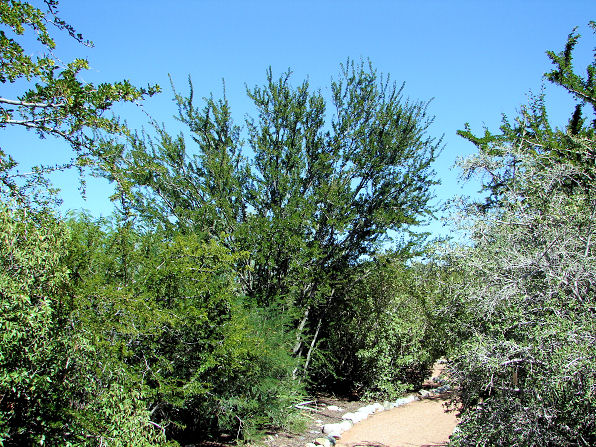 |
| Blackbrush Acacia, Acacia rigidula. Photo October 11, 2006. Boyce Thompson Arboretum, Near Superior, Arizona. |
|---|
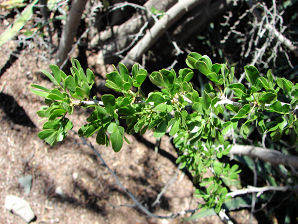 | 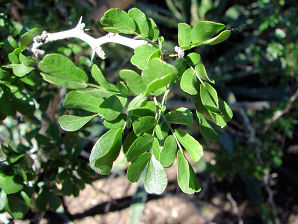 |
| Blackbrush Acacia Leaves. Acacia rigidula. | Blackbrush Acacia Leaf Structure. Acacia rigidula. |
|---|---|
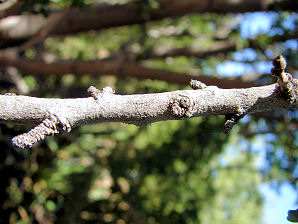 | 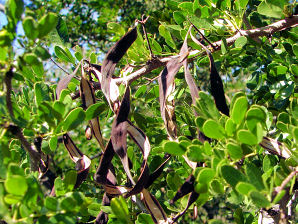 |
| Blackbrush Acacia Stem. Acacia rigidula. | Blackbrush Acacia Seed Pods. Acacia rigidula. |
Blackbrush Acacia Trees.
We wish to thank Wikipedia, the free encyclopedia for some of the information on this page. We share images and information with Wikipedia. This thorny little tree or shrub possess white to light-yellow flowers that appear in cylindrical spikes; they can be so abundant that they literally dominate the branch. The leaves are alternate and compound, with two to four (rarely five) pairs of leaflets, and they possess straight spines. Most people, as well as bees, appreciate these lovely shrubs when flowering; they make especially good honey. Blackbrush is usually a muli-stemmed shrub or tree with numerous thorny branches sprouting from the base. It possess white to light-yellow flowers that appear in cylindrical spikes. It grows typically from three to fifteen feet high. Chaparro Prieto produces many white to pale yellow flowers from early March to mid - June. Small mammals and birds inhabit this plant for protection. This plant is often used in rock gardens, landscapes, or xeriscapes. Acacia rigidula (Black Bush Acacia) is a deciduous tree, native to western and southern Texas and a several northeastern Mexican states. In natural setting it is typically found on rocky hillsides and along canyon floors at elevations from 1100 to 1800 feet above sea level. It occurs as scattered individual plant and in clumps or thickets. Under natural growing conditions the tree matures to about 10 to 15 feet tall and as wide but will likely grow larger in landscape settings. Gavia has yellow to cream colored flowers arranged in 2 to 3 inch long, slender spikes appear from March to mid-June. Then slender pods about 3 inches long develop from these flowers. The tree is deciduous and the branches are armed with numerous thorns. Black Bush thrives in full sun and a variety of soil types and conditions including very poor calcareous (caliche) soils. Trees grow at a moderate to slow rate. Regular irrigation is needed at first but after it is growing for a few years it will survive on desert rainfall. However, monthly summer irrigation of the mature, established trees will optimize their growth and appearance. The unique charm of this tree, besides its modest statue, is its dark green, glossy, foliage, which is borne on stiff, densely packed, gray barked branches. Black Bush is an excellent screen, barrier, or foundation plant, or as a backdrop for other flowering plants or for erosion control. Specimens can be left as a large mounding shrub or pruned to a sculptural tree form that accents the contrast between green leaves and gray bark. It is slow growing; needs good drainage, tolerates a wide range of soils; low water use, and full sun, it is hardy to 20�F. Often people confuse this tree with a mimosa. Acacias and mimosas are often so similar they are difficult to tell apart. But the key difference is in the flowers themselves: acacia flowers possess numerous (20-100) stamens, while mimosas possess 10 to fewer stamens per flower. And mimosa fruits (pods) are flattened and somewhat contorted. The nations largest Blackbrush tree is located in Casa Grande, Arizona. It is in the National Register Of Big Trees. It is over 26 feet tall and 29 feet wide. The second runner up is in Glendale, Arizona; at the Mountain States Nursery.
Quick Notes:
Height: Normally, 3 To 20 feet tall; up to 18 feet wide.
Trunk: 3 to 10 inches in diameter.
Bark: Grayish-brown, thin, smooth or scaly.
Twigs: Stiff, densely packed, gray barked branches.
Flowers: Yellow to cream colored, very fragrant flowers arranged in 2 to 3 inch long, slender spikes.
Blooming Time: Early March to mid - June.
Seed Pod: Slender pods about 3 inches long.
Seeds: Dark brown or black, hard.
Leaves: Alternate and compound, with two to four (rarely five) pairs of leaflets, and they possess straight spines.
Found: In the Chihuahuan desert. The USDA claims it is native to the USA (TX). In Texas it is mainly on the Edwards Plateau and the South Texas Plains. We have found that it is also native to southeastern New Mexico. Also native to Chihuahua, Tamaulipas, & Coahuila in Mexico; extending furthers southward into Hidalgo, Quer�taro, San Luis Potos�, Veracruz, & as far as into the central Mexico state of Oaxaca.
Elevation: Native below 1,800 Feet. Said to live up to 4,500 feet.
Hardiness:
Soil pH requirements:
Sun Exposure:
Habitat: Rocky hillsides, alluvial plains, canyon slopes, and hillsides. Xeriscape ornamental in lower elevations in the Phoenix and Tucson areas of Arizona.
Miscellaneous: Photos Taken At October 11, 2006. Boyce Thompson Arboretum, near Superior, Arizona. A low water use landscaping plant in the Phoenix and Tucson areas.
|
We Are Proud Of Our SafeSurf Rating!
Click On Any Of The Following Links By Amazon.Com
For Books, & Videos About Wildflowers Of Arizona & The Southwest USA. No Obligation!
| © 1966 - Present, Audrey, Eve, & George DeLange |
